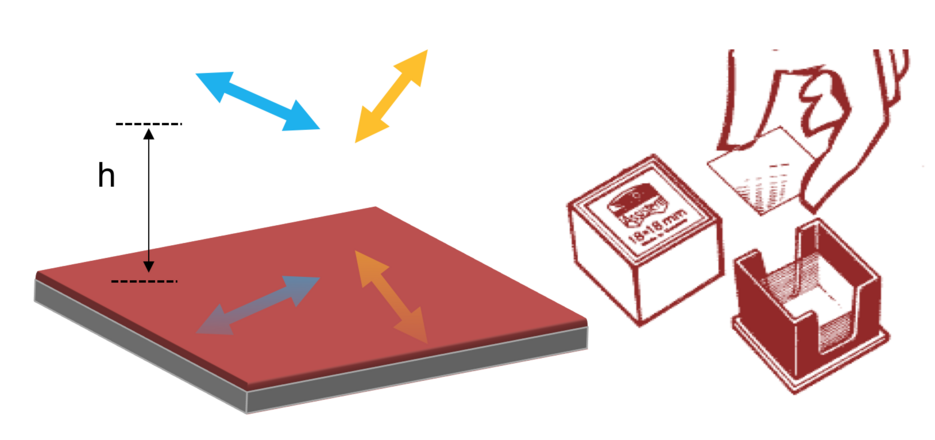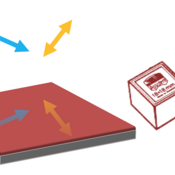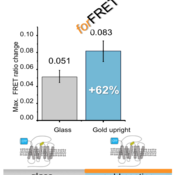Forbidden FRET situations on wafer-thin gold
04/09/2018G protein-coupled receptors (GPCRs) are the major target molecules for drug discovery. Scientists at the University of Würzburg and the University Hospital Jena have now been able to explore the activation of these receptors in more detail by developing a modern microscopy technique. Increasing the Förster Resonance Energy Transfer (FRET) through the use of specially coated coverslips was the key.

This new method could help single-cell measurements to more precision as well as optimize high-throughput screenings, which play a major role in drug development. The results were published in the journal ACS Photonics.
If one wishes to observe the conformational change or interaction of membrane receptors in living cells, light microscopy is often the method of choice. One phenomenon that allows these changes and interactions to be studied, is the so-called Förster Resonance Energy Transfer (FRET). It always appears when two fluorophores with suitable spectral properties get together very close in space, and are in correct orientation to each other.
Every photon counts
FRET serves as a molecular ruler between two molecules or molecular compartments. The method is powerful, but often limited by the restricted number of photons emitted. It makes the design and establishment of a corresponding FRET pair difficult and error-prone. In biological studies, it is particularly difficult to optimize the proximity and orientation of the fluorophores without disrupting the physiological properties of the molecular complex.
Mirror effect allows "forbidden" states
The research teams of Professor Katrin Heinze and Professor Carsten Hoffmann have now lowered the limits for using FRET as a method. The research groups have used nano-coated coverslips, applying special gold coatings. These biocompatible coverslips enhance the energy transfer, especially for suboptimal oriented FRET pairs. Among other reasons, this works because the FRET pair "sees" itself in the mirror as a result of the gold coating. This allows complementary orientations for the energy transfer increasing the "net" FRET. The mirror effect thus allows the demand of otherwise "forbidden" states for FRET. In physics, this effect is called depolarization, caused by the complex reflection behavior of the FRET pair near the gold surface.
For a long time it was disputed among physicists, whether there can be a sufficiently strong FRET increase; Though the orientation of the molecules was never sufficiently considered. Recent theoretical and experimental studies on physical systems, however, gave reason to consider the possibility of FRET amplification.
"Discussions with other experts in the research field gave us reasons to be cautiously optimistic. However, our simulations for the FRET sensor of the M1 acetylcholine receptor showed that FRET enhancement is very likely. The experiments finally confirmed our predictions. This is how our "forbiddenFRET (forFRET)” method was founded ”, says Katrin Heinze. Carsten Hoffmann adds: "Although this technology is only just at the beginning, it has great potential to make the analyses of GPCR activations and interactions even more precise in the future."
Publication
Schreiber, Benjamin; Kauk, Michael; Heil, Hannah; Emmerling, Monika; Tessmer, Ingrid; Kamp, Martin; Höfling, Sven; Holzgrabe, Ulrike; Hoffmann, Carsten; Heinze, Katrin: Enhanced fluorescence resonance energy transfer in G protein-coupled receptor probes by nano-coated microscopy coverslips; ACS Photonics, March 2018, DOI: 10.1021/acsphotonics.8b00072
People
Prof. Dr. Katrin Heinze has been head of a research group at the Rudolf Virchow Center for Experimental Biomedicine at the University of Würzburg since 2011. Since 2017 she is University Professor of Molecular Microscopy. Website
Prof. Dr. Carsten Hoffmann was a research group leader at the Rudolf Virchow Center for Experimental Biomedicine at the University of Würzburg from 2012 to April 2017. Since April 2017 he is Director of the Institute of Molecular Cell Biology at the University Hospital Jena. Website
About the Rudolf Virchow Center
The Rudolf Virchow Center is a central institution of the University of Würzburg. All research groups are working on target proteins, which are essential for cellular function and therefore central to health and disease.
Contact
Prof. Dr. Katrin Heinze (Molecular Microscopy, Rudolf Virchow Center)
Tel. +49 (0)931 31 84214, katrin.heinze@virchow.uni-wuerzburg.de
Prof. Dr. Carsten Hoffmann (Institute for Molecular Cell Biology, University Hospital Jena)
Tel. +49 (0)3641 9395601, carsten.hoffmann@med.uni-jena.de
Dr. Daniela Diefenbacher (Press Office, Rudolf Virchow Center)
Tel. 49 (0)931 3188631, daniela.diefenbacher@uni-wuerzburg.de
- Related News:
Researchers identified an important signaling molecule of cell communication - 23.03.2016 19:00




